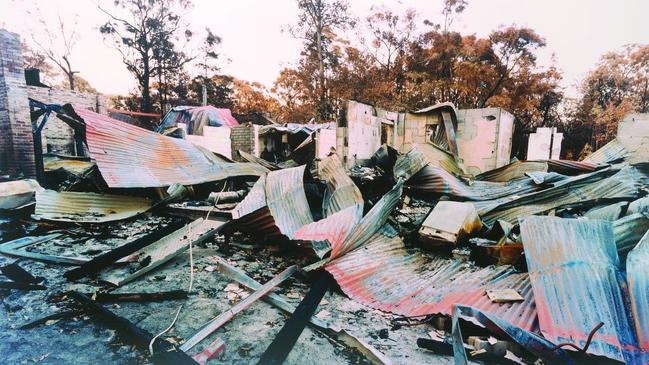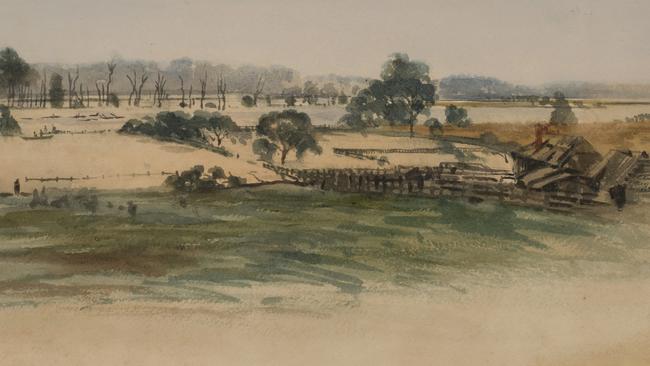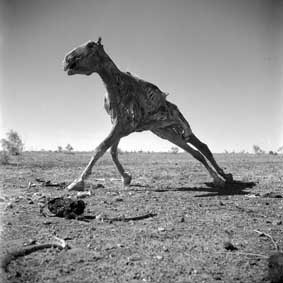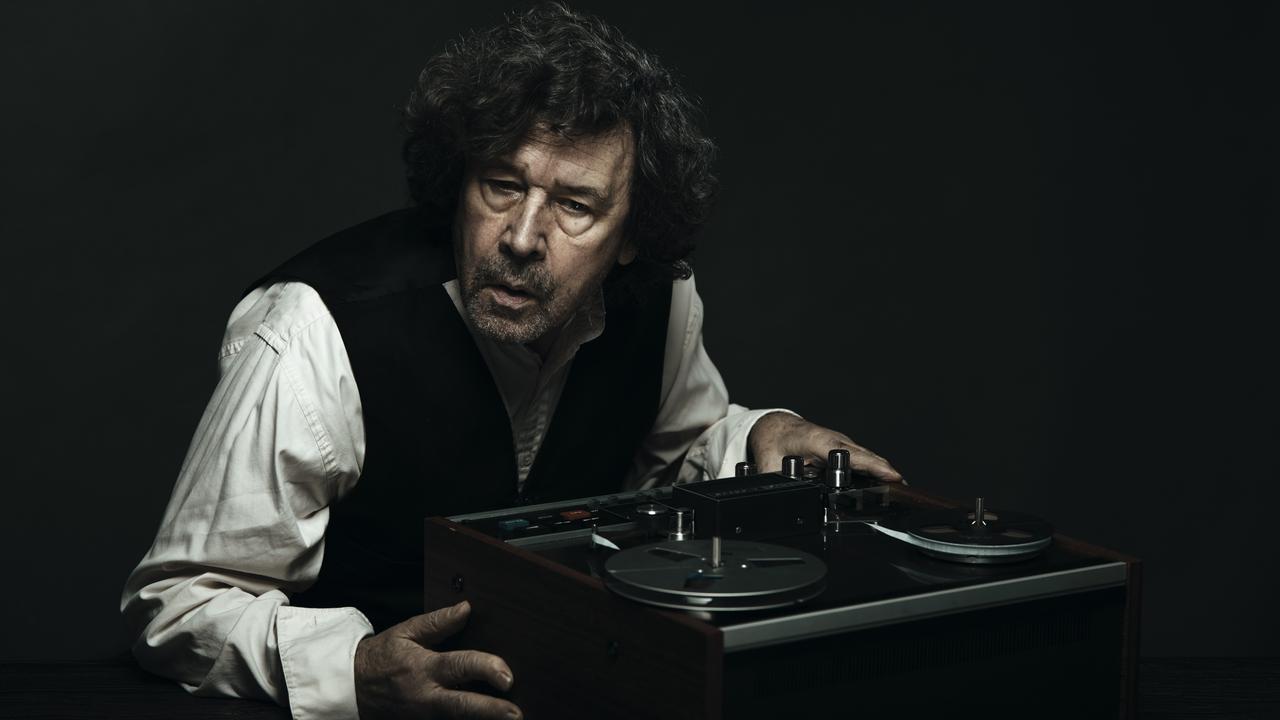Review, Wonder and Dread at Shoalhaven Regional Gallery
Can reflecting on the havoc wreaked by flood, fire and drought teach us something about the future?

Australia has always been a land of harsh and extreme weather, and perhaps most importantly, of unpredictable conditions. Humans are highly adaptable, and around the world we manage to live in hot and cold, wet and dry environments. But in most of these places there is some regularity in the cycles of the seasons, and in many there is either frequent and dependable rainfall or access to water from large rivers.
Here, on the other hand, weather patterns dominated by the irregular and still not fully understood El Nino Southern Oscillation make our seasons less predictable, and expose us to the all-too-familiar alternation of catastrophic droughts and floods. This phenomenon affects the Pacific coast of South America and the tropical countries to our north as well, but most of these lands have more fertile soil and an abundance of edible plants.
The discovery of the Americas added countless important — and now almost indispensable — foods to the Eurasian diet, notably potatoes, sweet potatoes, tomatoes, chilli and peppers, maize, avocadoes, cacao, peanuts, pineapples, pumpkins and squash and even green beans, which came from Peru.
Australia has many more or less edible plants, but the most significant contribution our continent has made to the diet of the world is the macadamia nut.
Under the circumstances, it is hardly surprising that agriculture never developed here — the poor soil and unpredictable rainfall would presumably have discouraged any tentative steps in that direction — although as we now know, the Aboriginal people developed ingenious forms of land management, especially the clearing of open land by burning to attract animals like kangaroos that could then more easily be hunted.
European settlers soon succeeded in establishing farming, but they continue to struggle with the difficult conditions, while practices adapted to richer soils with more abundant water but less suited to Australian conditions have often resulted in serious damage to already fragile or marginal environments. Water management has become an increasingly critical problem in the age of climate change; there are no doubt crops that should be abandoned as unsuitable for our country, and areas where reafforestation and regeneration should replace farming.
Extreme weather is the subject of an exhibition at the Shoalhaven Regional Gallery in Nowra, in an area that has recently experienced both terrifying bushfires a year ago — following months of drought — and then in August the worst flooding for 30 or 40 years. The earliest piece in the show, however, records a catastrophe two centuries earlier: it is a watercolour by an anonymous artist in 1816, at a time when, still almost a generation before the beginnings of photography, drawing and watercolour painting were fundamental practical skills and a part of the training for many professions.
The picture shows the Hawkesbury River in flood; in the distance on the right can be seen a small township, which must be Windsor. This was already an important outpost of the colony, for — as I noted in a review around six months ago — Governor Phillip had sailed up the Hawkesbury as early as March 1788 and then again in June 1789, looking for better farmland than was to be found in the immediate vicinity of Sydney Town.
Settlement began soon after, and the town of Windsor was proclaimed by Governor Macquarie in 1810.
This view appears to be looking right across the broad expanse of valuable but submerged farmland, dotted with treetops and crisscrossed by several rowing boats, while a deeper-water vessel with two masts is moored near the town, in what must be the normal course of the river.
A much later colonial watercolour is by the local amateur artist Samuel Elyard (1817-1910), and belongs to the Regional Gallery’s permanent collection. Flood from Ferry Lane 1870 records a disastrous flood that, according to the accompanying label, “destroyed many properties and a large part of the emerging township of Terrara, as well as the Bomaderry Ferry Wharf”. As a result, Terrara, on the right or south bank of the Shoalhaven opposite Bomaderry on the left or north bank, was virtually abandoned for the higher site of Nowra nearby; in 1881, the first Nowra Bridge was built, which will become a pedestrian and cycle bridge with the opening of the third Nowra Bridge, currently under construction.

Alan McFetridge has rephotographed the sites of two colonial views, John Glover’s The River Derwent and Hobart Town (c. 1831) — a picturesque area named “Salvator’s Glen” in recollection of the 17th-century landscapes of the Neapolitan Salvator Rosa — and Eugene von Guerard’s lithograph of the Junction of the Buchan and Snowy Rivers (Plate 9 in Eugene von Guerard’s Australian landscapes, 1866-68). His photographs — of the first site overgrown and the second devastated by bushfire — are set beside reproductions of the originals.
The accompanying label claims that the two painters unwittingly recorded landscapes managed by traditional Aboriginal burning, the cessation of which has brought them to their present state. This may be true, although neither site corresponds to the grassy plains that were particularly noticed by early colonists — some of whom did realise that the Aborigines regularly burned the land — and Von Guerard’s view does not show any obvious signs of fire; there are, however, burnt stumps on the left of Glover’s view and epicormic growth — leaves growing straight from the trunk — on one large tree on the right in particular.
Of course not all fires were either deliberately lit or managed, so it is hard to be sure what happened in this case. The most catastrophic early wild fires recorded and documented in Australia were the Black Thursday Bushfires in Victoria in 1851, the culmination of a terrible drought in the previous year. The fires were witnessed by William Strutt, who made sketches at the time and completed his dramatic painting of the subject after his return to England in 1864. The exhibition contains a reproduction of this painting and one of its studies.
Since then, of course, Australia has suffered from repeated disastrous bushfires, but there is little doubt that they have grown progressively more frequent and more intense in the past generation. A year ago, Australia was in the grip of the fires already mentioned, which ended up burning almost 19 million hectares of bushland and farmland. As they settled down towards the end of summer, we thought that this would be the traumatic event that would mark 2020; but then the pandemic appeared and monopolised our attention.
Other works in the exhibition evoked different natural disasters: there is Marcia Macmillan’s striking photograph of her daughter running towards the tsunami-like wave of a red dust storm at Nyngan, which won the Landscape Prize at this year’s Head On Photographic Festival; and not too far from Nyngan, at Broken Hill, another dust storm was painted in the 1960s by the naive artist Sam Byrne (1883-1978), and shows a massive cloud of dust rolling over what still looks like a colonial or at any rate early 20th-century regional city.
Drought is evoked in a stark photograph of a dead galah lying on the sun-parched earth; the image is moving and powerful in itself, but subjected to some tendentious over-interpretation in the accompanying label. Floods, on the other hand, are Max Dupain’s subject in an aerial photograph of the Burdekin River in flood (1943), where snakelike tributaries flow into the swollen river and reflected clouds hint at more rain to come.
Rosemary Laing’s two large photographs are again devoted to fire, this time the Black Christmas bushfires that burnt around Sydney and covered the city in a pall of smoke in December 2001 and into the beginning of 2002 — as the Millennium drought reached its peak before breaking with the La Niña event of 2010-11.
One of Laing’s pictures shows John and Kathy’s auto-services (2002-04), an establishment reduced to the tangle of twisted corrugated-iron roofing that was perhaps first represented in art in Russel Drysdale’s paintings of abandoned or burnt-out rural homes. The metal sheeting is all in deceptively soft hues of blue and pink, contrasting with the roofless shells of building behind. The other picture is an interior, Chris’s shed (2002-04), and reminds me of an interior I witnessed in the Shoalhaven earlier this year: all the contents of the building reduced to charred and blackened rubble, with just a few objects still recognisable and seemingly intact, like a china mug.
In contrast to these images of particular disasters, a large multi-projector installation by Susan Norrie, Undertow (2002) muses on environmental destruction in general. One screen shows boiling tar, evoking industrial processes while recalling pictures of the torments of hell. Another shows rescuers trying to save a seabird caught in an oil-spill.
Particularly effective is footage of the terrible dust-storm that struck Melbourne on February 8, 1983, itself a consequence of the 1982-83 drought, and a forerunner of the Ash Wednesday bushfires that followed a week later on February 16. The line of trucks driving slowly through the dust with their headlights on in the middle of the afternoon is claustrophobic and menacing.

The most striking works in the exhibition, however, are four photographs taken by Sidney Nolan. Like Russell Drysdale, who had been sent by The Sydney Morning Herald in 1944 to document the World War II drought in western NSW, Nolan was sent by the Brisbane Courier-Mail in 1952 to report on yet another terrible drought in the outback. The photographs he took were too shocking to be published, ending up in a cigarette tin for 40 years until after the artist’s death.
These are indeed confronting images, including a calf whose body has mysteriously but horribly ended suspended in the branches of a dead tree, and three horses. One of these is just skull and neck, its muzzle on the dry ground, its teeth bared, half the skull exposed and yet its ears still pricked up as though alive.
The other two are particularly memorable. In one, a reclining horse turns its head towards us, while another seems to be still running: both look as though death has frozen them in mid-action and then the heat has desiccated their carcasses into these hollow forms of bone and leather.
It is not surprising to learn that Nolan himself thought of the obvious comparison — the pathetic body-casts from Pompeii that preserve the forms of men and women trying to shelter themselves or those they love from the all-consuming and instantly fatal heat of the volcanic blast.
The particular pathos and mystery of these figures is how what must have been a slow and agonising end in heat and thirst can have produced the same kind of effect of suspended action and paradoxical vitality as an almost instantaneous death. At any rate, it is a reminder that the results of slow catastrophes and sudden ones can be unexpectedly equivalent.
Wonder and Dread: Art in the Land of Weather Extremes, Shoalhaven Regional Gallery , until January 30.






